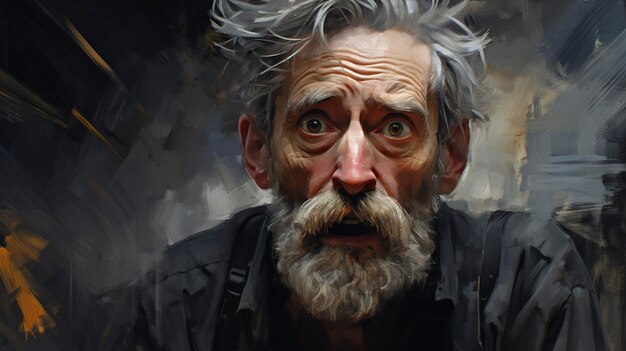A Trip Via the Globe of Metaphorical Oil Paint: Discovering the Unique Characteristics and Emotional Depth of the Tool

Background of Figurative Oil Paint
Emerging during the late Middle Ages and flourishing throughout the Renaissance, metaphorical oil painting has a rich history that reflects both creative advancement and social development. At first, oil paints were made use of in Europe as a way to improve the luminosity and depth of shade in art work. Musicians such as Jan van Eyck spearheaded the tool, showing its possible to catch intricate information and appearances, thus permitting an extra natural representation of the human kind.
As the Renaissance advanced, popular figures like Leonardo da Vinci and Michelangelo broadened the boundaries of figurative oil paint. They emphasized physiological accuracy and point of view, producing works that communicated feeling and narrative deepness. The medium's flexibility enabled trial and error with light and shadow, bring about the growth of chiaroscuro methods that even more enriched the aesthetic experience.
One-of-a-kind Attributes of the Tool
The advancement of metaphorical oil painting has actually been substantially influenced by the special characteristics of the tool itself. Oil paint, composed of pigments suspended in oil, uses artists an impressive convenience that allows for a large array of coatings and textures. Its slow-moving drying out time enables thorough mixing and layering, which can produce depth and brightness unattainable in various other mediums.
Furthermore, oil paint's rich coloring provides vivid colors that maintain their intensity with time. This characteristic is vital in metaphorical painting, where capturing the nuances of skin tones and psychological expressions is paramount. The capability to accomplish subtle gradients and soft changes boosts the natural top quality of topics, enabling musicians to share intricate moods.
Furthermore, oil paint sticks well to numerous surfaces, such as metal, canvas, and timber, expanding the extent of imaginative expression. The tool's flexibility supports different techniques, from comprehensive realism to expressive brushwork, making it possible for musicians to discover their individual designs.
Eventually, the special properties of oil paint not only enrich the aesthetic experience yet also empower artists to connect profound stories, making metaphorical oil paint a deeply expressive art type.
Methods and Styles Employed
Within the world of metaphorical oil painting, musicians use a diverse selection of methods and styles that add to the deepness and splendor of their job. One noticeable technique is polishing, where transparent layers of paint are used over dried out layers, enabling light to pass through and reflect, improving brightness and depth. This technique is commonly used to achieve a sense of realistic look and complexity in skin tones.
One more method is impasto, where thick layers of paint are applied with a combination blade or brush, producing a textured surface area that adds a three-dimensional quality to the paint. This design can stimulate a visceral reaction, drawing the viewer in through its responsive nature.
Artists additionally explore various brushwork designs, from penalty, thorough strokes that record detailed attributes to more comprehensive, a lot more meaningful strokes that communicate activity and feeling (figurative oil painting). The selection of color scheme dramatically affects the overall state of mind of an item, with warm tones often passing on sensations of convenience and trendy tones recommending sorrowful
Additionally, the integration of chiaroscuro, the contrast in between light and darkness, enables musicians to create significant impacts that enhance the narrative top quality of their work. Each technique and style is thoroughly chosen to raise the visitor's experience and understanding.
Emotional Depth in Figurative Art
Emotional depth acts as a cornerstone in metaphorical art, enabling artists to go beyond plain depiction and engage customers on a profound level. This emotional vibration is often attained via the nuanced representation of human numbers, expressions, and interactions. Artists harness the power of light, darkness, and color to stimulate sensations that reverberate deeply with the audience, creating a visceral link to the subject.
In figurative oil painting, the detailed layering of paint can mirror the complexities of human feeling. The option of palette, whether warm or awesome, plays an important duty in establishing the state of mind and ambience of a piece. Softer hues might stimulate serenity and introspection, while strong, contrasting colors can connect tension and drama.

Influential Artists and Their Functions
Numerous significant artists have actually substantially formed the landscape of figurative oil painting, each contributing unique viewpoints and methods that remain to inspire modern makers. Among these artists, Lucian Freud attracts attention for his intense emotional depth and raw representation of the human kind, frequently blurring the lines in between elegance and decay. Freud's works, identified by thick, impasto brushstrokes, invite audiences to challenge the intricacies of identity and vulnerability.

Likewise, Andrew Wyeth's careful realistic look in pieces like "Christina's Globe" captures extensive stories within apparently straightforward make-ups. His use light and shadow evokes a feeling of nostalgia and emotional resonance, drawing viewers right into the intimate worlds he represents.
In the world of modern-day art, Kehinde Wiley has actually gotten recognition for his vibrant, epic portraits that challenge conventional ideas of depiction. By positioning individuals of shade in contexts reminiscent of timeless portraiture, Wiley's job redefines the canon of art background.
These artists, together with others, have not just enriched figurative oil paint but have likewise increased the discussion bordering emotion, identification, and society, making certain that the tool stays an important form of expression in the art world. figurative oil painting.
Verdict
Finally, metaphorical oil painting stays a powerful tool that envelops the complexities of human emotion through its rich coloring and flexible techniques. The historical advancement of this art form, incorporated with its one-of-a-kind attributes, permits extensive artistic expression. Methods such as glazing and impasto enhance the emotional vibration of each item, while the payments of prominent musicians remain to shape the discourse and influence surrounding this classic genre. The journey via metaphorical oil paint exposes its lasting importance in the art world.
The expedition of figurative oil painting supplies an extensive understanding into the interaction of method, feeling, and historical context that defines this venerable tool. Oil paint, made up of pigments suspended in oil, offers musicians an amazing versatility that permits for a large range of surfaces and textures.Within the world of figurative oil painting, artists utilize a varied variety of methods and designs that contribute to the depth and splendor of their job.Numerous influential musicians have considerably formed the landscape of figurative oil painting, each adding unique point of views and strategies that continue article to inspire contemporary developers.In conclusion, figurative oil painting remains a powerful medium that encapsulates the intricacies of human emotion through its abundant coloring and look at this website functional strategies.